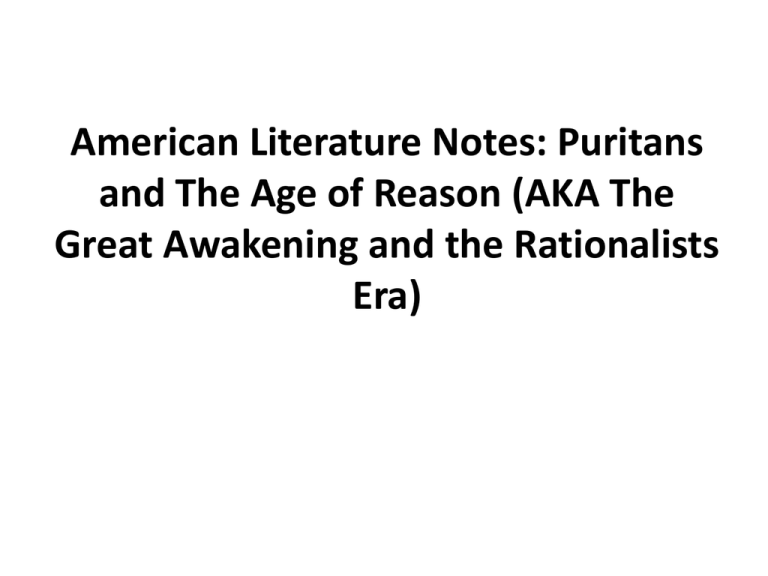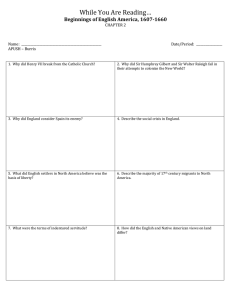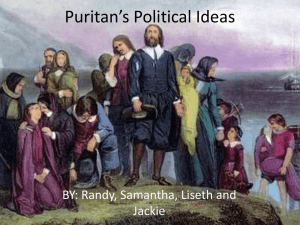American Literature Notes: Puritans and The Age
advertisement

American Literature Notes: Puritans and The Age of Reason (AKA The Great Awakening and the Rationalists Era) I. ____________Period (pre-1600 to 1760) 1. Begins with ___________literature of Native Americans 2. No __________ literature among the more than 500 tribes before Europeans came 3. Native American stories show deep respect for ____________. 4. Nature contains _______________. 5. Main characters may be _______or __________ 6. The focus was on ______more than the ________ person 7. This period was ____________for the __________ A. The literature of Exploration 1. The written record of Jamestown (founded 1607) (before the Pilgrims) is mainly that of ________________. a. John Smith was an incurable __________ b. He stretched _____________in his stories c. _________________is the most famous story of John Smith. 2. Later in the 1600’s, ___________, _____________, and ______________opened the way for a second wave of settlers at Plymouth a. Their literature consisted of ___________, __________, ______________, and _____________. b. Because England eventually took control of the colonies, the best known colonial literature is _______. (Meaning from England and like England’s writers.) c. Today we are “discovering” the literature of many minorities who came here at the same time. B. The Puritans of New England (the North) 1. Puritans were probably the most ____________colonists of any in history a. Between 1630-1690 many university graduates came to America. b. Most educated people of that time were wealthy and not willing to risk the wilderness life 2. Puritan writing a. Mostly ___________because they were a ______________society b. We learn a lot about them from their ________________ c. Puritan Themes were (1) _________________________, (2) ________________________________, and (3) _______________________________________. d. To the Puritans, the world was an arena where ________and ______________constantly fought 3. Puritanism a. Rests on ______________________________________________ . b. Puritans felt earthly _________________was a sign that they were one of the __________________(bound for heaven) / Today many Americans applaud material success too. 4. The Puritans believed everything that happened was “God’s will” Here is a passage from William Bradford’s Of Plymouth Plantation describing what happened to a sailor (not a Pilgrim) on the Mayflower during the passage to the New World. Underline the words that make you agree with this statement. And I may not omite hear a spetiall worke of Gods providente. Ther was a proud and very profane yonge man, one of the sea-men, of a lustie, able body, which made him the more hauty; he would allway be contemning the poore people in their sicknes, and cursing them dayly with greevous execrations, and did not let to tell them, that he hoped to help to cast halfe of them over board before they came to their jurneys end, and to make mery with what they had; and if he were by any gently reproved, he would curse and swear rnost bitterly. But it plased God before they came halfe seas over, to smite this yong man with a greeveous disease, of which he dyed in a desperate maner, and so was him selfe the first that was throwne overbord. 5. To the Puritans, history was symbolic of them triumphing over the New World. 6. The “Separatists” (Puritans who “separated” themselves from the Old World to avoid persecution) interpreted the Bible literally. Many Americans today do the same. 7. The Puritans believed in public education, which is why you are sitting in this room right now! II. The Revolutionary Period (1760-1820) The Revolutionary War took place in this time. 1. Military victory over England brought hope of ____________________ 2. Excellent _______________, but no great new literature came 3. American books were considered __________________ in England 4. The not-yet-invented invented ___________________became a national obsession 5. Unfortunately, we were still so culturally tied to England that we simply ___________the styles being written there in _____________________________. 6. American authors also had a small audience because _______________________________________________________________ 7. Lack of adequate copyright _________in America hurt – why pay an unknown American writer for a book when you could print an unauthorized copy of a foreign one and not get penalized? This hurt both American and English authors. 8. This period was _________________instead of _______________________ A. The American Enlightenment 1. This was marked by ______________over ________________, and ___________________instead of ___________________________________ 2. Writers and thinkers were devoted to __________________________________. 3. __________________is a good example a. Poor Richard’s Almanack b. The Autobiography B. The Political Pamphlet 1. Over 2,000 ______________were published during the ___________ 2. They thrilled __________and threatened ____________ 3. Very dramatic; often read aloud to excite public audiences 4. American _______________read them in camps; British ______________burned them 5. Thomas Paine a. Common Sense sold over 100,000 copies in first 3 months of publication Published in 1776, Common Sense challenged the authority of the British government and the royal monarchy. The plain language that Paine used spoke to the common people of America and was the first work to openly ask for independence from Great Britain. Common Sense came before the Revolutionary War. “IN the following pages I offer nothing more than simple facts, plain arguments, and common sense; and have no other preliminaries to settle with the reader, than that he will divest himself of prejudice and prepossession . . . .” B. The Crisis is a collection of articles written by Thomas Paine during the American Revolutionary War. After the colonists in America decided that they were going to attempt a move towards freedom from British rule, they found themselves faced with several problems. Many of these problems dealt directly with the threat of a British invasion to stamp out such a revolution. However, a major problem was an internal one. The feelings regarding independence were mixed throughout the colonies and divided among classes. The Patriots found themselves among many devoted British loyalists who were totally against any ideas of secession. b. “The Crisis” encourages colonists to fight England for freedom and contains the following famous lines: “These are the times that try men’s souls . . .” and “The summer soldier and the sunshine patriot will, in this crisis, shrink from the service of his country . . .” 6. Political pamphlets had to be ___________________ 7. In order to have an informed electorate, the founding fathers encouraged ______________________ 8. One indication of a vigorous literary life in the colonies was the large number of _______________ a. More newspapers read in America then than anywhere else in the world b. Immigration required simple style in papers; clarity was important C. Neoclassicism became popular in writing (neo = new; classicism = classics) Many American writers tried to copy the classical style; especially the epic (a long, narrative poem telling the deeds of a legendary hero) Therefore, no new “American style” in writing had yet emerged. Ironically, the first truly “American style” came in furniture design. D. Fiction – the first important American fiction writers used American subjects, historical perspectives, themes of change, and nostalgic tones. 1. Washington Irving took his story ideas from European folk tales a. Legend of Sleepy Hollow b. Rip Van Winkle 2. James Fenimore Cooper took his story ideas from America; the ironic and tragic destruction of the wilderness which had drawn us here in the first place a. The Last of the Mohicans b. The Leatherstocking tales where the Hero is Natty Bumppo: The Leatherstocking Tales is a series of novels by American writer James Fenimore Cooper, each featuring the main hero Natty Bumppo, known by European settlers as "Leatherstocking," 'The Pathfinder", and "the trapper" and by the Native Americans as "Deerslayer," "La Longue Carabine" and "Hawkeye". 1823 – The Pioneers, 1826 – The Last of the Mohicans, 1827 – The Prarrie, 1840 – The Pathfinder, 1841 – The Deerslayer,






